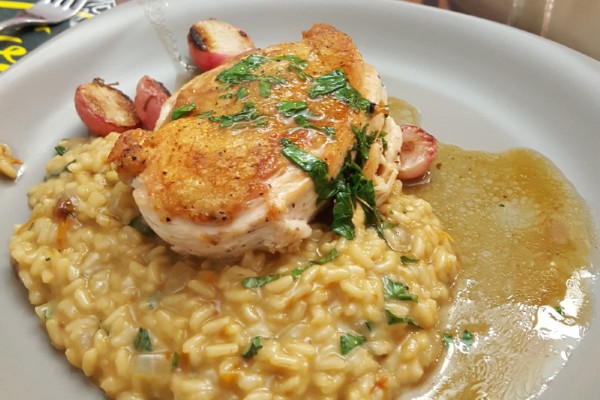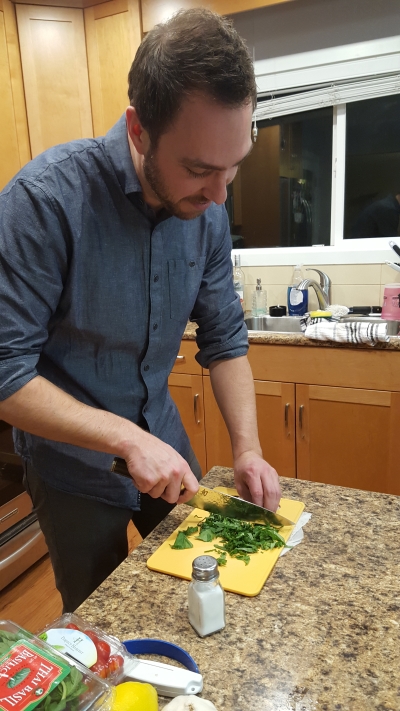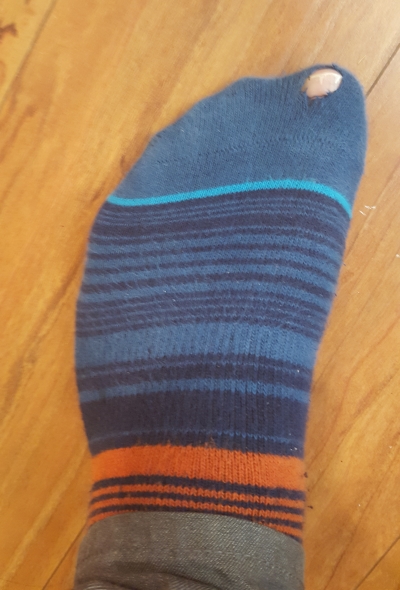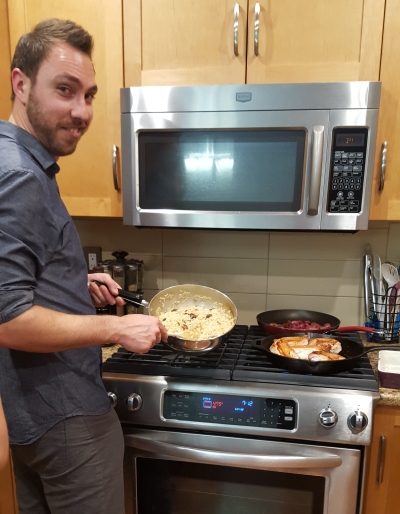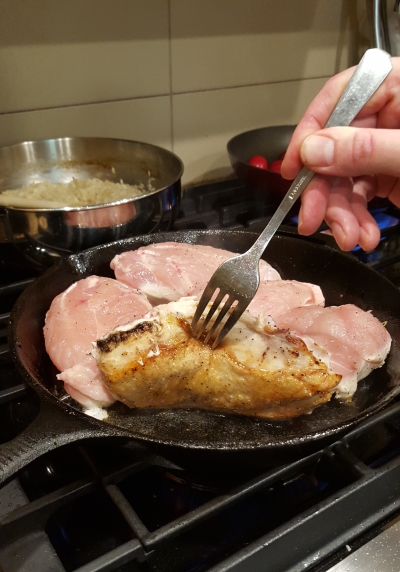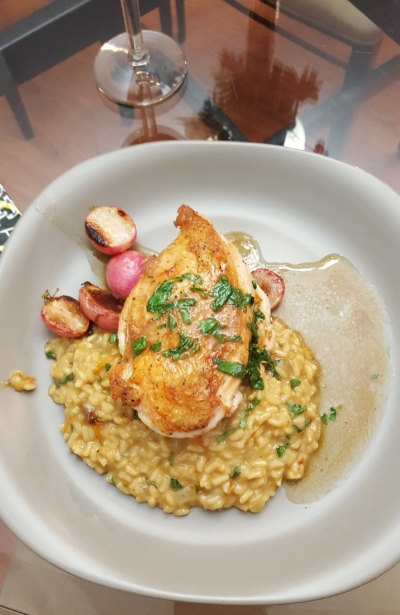Pan Fried Chicken, Risotto & Roasted Radishes
Friday was finally here. I had survived my first working week of cooking and other than a few late nights, a lot of grocery runs and some hard relationship lessons everything had gone pretty well.
This was the day I had been waiting for though. Up till now every dish I had attempted I had been at best winging it and hoping for the best. Now I was actually going to work with a professional chef!
Ben Pallett owns his own catering company, ‘Kitchen Sync Catering‘ and before that he worked at some of the best restaurants/wineries in town. I met Chef Ben through the Jr Chamber and when I told him about my challenge to scale my life and become a better cook he was stoked to help me out and be a part of it.
I was so excited to have Ben on board, this was really going to help step my amateur game up to the next level; he did not disappoint.
Ben showed up at my house with a cooler full of pots, pans, ingredients and 3 large full chickens. “You ever carve up a chicken?” he asked. “Only after its been cooked, and usually because I bought it pre-made from Safeway.” I replied. “Well you’re going to learn tonight.” he said, as he slammed the chickens down onto the cutting board.
We were going to make 3 different meals:
- Pan Fried Chicken Breasts with Risotto and Roasted Radishes
- Braised Chicken Thighs
- Slow Cooker Chicken Stock
He began by showing me some important pro chef skills.
Cutting & Knifes:
I own two different kinds of knifes, nice German steel knifes and an amazing Japanese steel one that some friends had gotten me for my birthday last year (thanks Matt and Dez). I’ve never sharpened them and I wouldn’t begin to know how.
Chef Ben’s Notes:
Sharpness:
- To test if your knives are sharp, try cutting a piece of paper. Hold it in the air and drag your knife from top down. If it cuts clean, its sharp. If it sticks and grabs, you’ve got a dull knife.
- Japanese blades should be sharpened at a 10-12% angle, where as German blades should be a 20-30% angle. You can buy different sharpeners for different angles or an adjustable one.
- A ‘Steel‘ the baton looking thing in your knife block is for maintaining a blade but won’t actually sharpen. To sharpen you need an actual sharpener or sharpening stone.
Safety & Technique:
- Never reach over or under your knife hand when cutting (I did this and lifted my hand too fast and nicked my hand)
- Put a damp paper towel underneath your cutting board so it won’t slip around on you. This makes a big difference so give it a try.
- Keep your left hip up against the counter (if right handed) and try to look down directly over what your cutting.
- When dicing, try to keep the front of your blade on the cutting board. Just lift the back of the blade and slice as you go along.
- Don’t force anything when cutting…that’s when accidents happen.
I started to work carving up the chickens. I wasn’t 2 seconds in before he stopped me to give me the best cutting analogy I’ve ever heard!
Keep Your Quarterback Safe:
“When your cutting, imagine your thumb is a football Quarterback and your four fingers are Linesmen. If you have your Quarterback out from behind your Linesmen he’s going to get sacked (cut up), but if you keep your Quarterback in the pocket (tucked behind your fingers) he’ll be safe to make great plays.”
In other words, tuck your thumb behind your fingers so it doesn’t get sliced off when your cutting. Then make a ‘claw’ with your fingers and position the side of the blade up against your middle knuckle as a guide. Start dicing and slowly move your hand back along the item guiding the knife back to cut at whatever increments you’d prefer (I like the football analogy way better).
I carved up the chicken using my new-found knife wielding skills. The chicken breasts were to be added into our main course where as the thighs were placed in a deep roasting pan to braise for the next few hours. The remaining bodies and wings weren’t discarded but instead added to our slow cooker to make up our chicken stock. Since chicken broth is the foundation for almost everything, making my own would be a huge cost savor moving forward.
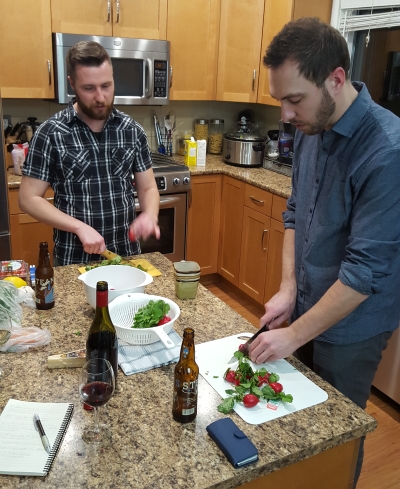 Watching Chef Ben make the chicken stock was beyond entertaining. He kept repeating, “this is just chicken stock so it doesn’t matter what it looks like,” as he sliced carrots, and celery in mid air hovering over the slow cooker. He tossed in a diced onion including the ends, with peal attached, he had cut off earlier.
Watching Chef Ben make the chicken stock was beyond entertaining. He kept repeating, “this is just chicken stock so it doesn’t matter what it looks like,” as he sliced carrots, and celery in mid air hovering over the slow cooker. He tossed in a diced onion including the ends, with peal attached, he had cut off earlier.
Ben then explained the core concept of great soups, stews, sauces and basically what all modern cooking was based on..,Mirepoix. Originally stemming from French cuisine, Mirepoix (meer-pwah) is made up of carrots, celery and onions which all carry a lot of flavor and can stand up to long cooking times making them the base components for many dishes.
Basically it was blaspheme not to know what it was and if I wanted to cook anything moving forward I needed to get educated real quick.
I then got ripped on for not having a cast iron pan (also important apparently) but luckily Ben had brought his own.
Chef Ben Note: Cast iron pans retain heat really well helping maintain temperature distribution. They are also oven safe, don’t have any harsh non stick chemicals and if kept well will remain non stick for pretty much ever.
Clumsy Cutting
Before the risotto went in I needed to dice up some onions. Chef Ben was walking me through his super cool, super fast way of dicing when I accidentally bumped my knife with my arm. In slow motion I watched helplessly as the knife fell from the cutting board down towards my frozen feet below. The knife bounced and I felt a sharp pain in my foot…
‘Oh no!’ I thought…did I just slice open my foot? I slowly began to unfreeze and react to what I could only assume would be moments before blood would be rushing out of my foot.
But nothing came. I went in for a closer inspection and low and behold the knife had fallen in such an angle that it narrowly managed to miss my toes. It had perfectly sliced a hole in my sock and I could now clearly see the top of my big toe sticking out from a blue surrounding. Thankfully though, there was no blood.
Of course instead of being physically cut up by my own knife, I was instead verbally cut up by Chef Ben for not keeping better control over my knives.. Out of the two though I didn’t didn’t really mind the latter.
Recovering from my clumsy cutting adventure I went back to my risotto. I used some butter to caramelize some diced up onions in a pan while Ben started pan frying our chicken breasts. After the onions had caramelized we added the Arborio rice and cooked until it began to get glossy and translucent around the edges. We then used some white wine to ‘deglaze’ the pan. I had done this before with my Italian Drunken Pasta but I wasn’t sure why we used wine and not water? To me booze was for drinking and making you seem smarter, not for cooking.
Ben explained that while water would work wine added a lot more flavor. You just had to make sure you reduced off all the alcohol before adding more ingredients.
Once the wine had reduced we slowly added some store bought low-sodium chicken broth, stirring occasionally to keep consistency.
Chicken Skills:
The chicken was much more complex to cook then I had anticipated.
Chef Ben Notes:
Prep:
- Pre-salt your chicken to enhance the natural flavor.
- Before adding your chicken make sure your pan is nice and hot and then reduce the temperature lower as you cook.
Cooking:
- If you hear continue to hear a sizzle you’re at a good temp, if not then you’ve gone too low.
- It’s important to cook the chicken skin face down for the first 75-80% to cook in all the best flavors, then at the end turn it over to crisp the other side.
The Boob Check:
- To tell if a chicken breast is done give it the boob check: If you poke it and it’s squishy like a boob it’s not done. If it’s hard like a peck, its done.
Resting:
- Cook meet 92% of the way and then pull it off and let it rest for 5-7 mins. If need be put the breast back on to heat right before serving.
Meanwhile the radishes had been roasting on a separate pan. We added some fresh basil and let simmer a few more minutes.
In the end we plated our meal and sat down to eat the most amazing moist chicken I can remember having. The risotto was creamy and delicious and our roasted radishes to my surprise were really tasty and were by far the simplest to make.
The braised chicken thighs we placed in the fridge after cooling for future meals and the chicken stock we left on low over night to stew and soak in all that mirepoix flavor.
Thanks Chef Ben for an amazing night. Your kitchen skills are masterful and it was great getting to know you and your family better.
